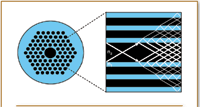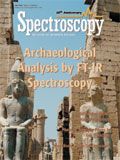Photonic Bandgap Fibers in Gas Detection
Spectroscopy
Photonic crystal fibers are novel optical waveguides that offer promising alternatives for various sensing applications. This article describes an experiment in which the absorption spectrum of acetylene was measured to demonstrate the effectiveness of photonic bandgap fibers for high sensitivity gas detection. Methane also was studied to determine the same capability in weakly absorbing gases.
Photonic crystal fibers are novel optical waveguides that offer promising alternatives for various sensing applications. This article describes an experiment in which the absorption spectrum of acetylene was measured to demonstrate the effectiveness of photonic bandgap fibers for high sensitivity gas detection. Methane also was studied to determine the same capability in weakly absorbing gases.
The fast development of fiber optics during the last few decades has revolutionized not only telecommunications technology but also has given rise to many important advances in photonic sensing technology with the invention of fiber gratings and polarization maintaining fibers, for example. Recently, an entirely new class of optical waveguides, the so-called photonic crystal fibers (PCFs), has emerged. These novel optical fibers offer new promising alternatives for a range of sensing applications due to their unique and easily tailored optical and geometrical properties (1).

Photonic crystal fibers often also called microstructured fibers or holey fibers can be classified in two categories: index-guiding fibers (2) and bandgap-guiding fibers (3). In index-guiding PCFs, air holes around the core decrease the effective refractive index of the cladding and consequently light is guided inside the core by total internal reflection as in conventional index-guiding fibers. In the case of photonic bandgap fibers (PBFs), light is guided by a two-dimensional photonic bandgap in a hollow core or in a core made of a material with the refractive index lower than the effective index of the cladding (see Figure 1). Due to the bandgap effect, certain light frequencies are not allowed to escape from the core, but will be reflected totally, leading to wavelength dependent light transmission.

Figure 1. Guiding principle of photonic bandgap fiber is based on multiple interference and scattering at the Bragg condition.
One major difference between manufacturing a PCF and a conventional optical fiber is in the fabrication of the fiber preform. A preform of PCF is manufactured by stacking a large number of silica rods and capillary tubes to form the desired fiber structure. To realize a PBF with an air core, usually seven or 19 silica tubes are removed from the center of the fiber preform. After the preform stack is made, it is fused and drawn to the final length using a traditional fiber drawing tower. The structure of the preform is preserved in the drawing process. A schematic of the fabrication process is shown in Figure 2.

Figure 2. Fabrication of photonic bandgap fiber by stacking method.
Although PCFs have been studied intensively during the last few years, their potential in the field of sensing still is largely unexplored. An especially interesting subclass of PCFs in this sense comprises air-guiding PBFs. It has been shown that such fibers can guide more than 99% of the mode field energy in the air-filled regions of the fiber (4, 5). This opens up new possibilities for exploiting the interaction of light and matter inside the hollow capillaries. By filling the holes of a PBF with a suitable gas, the fiber geometry naturally can provide long optical path length although only very small quantities of gas are required to fill the capillaries. Yet, another attractive feature of these fibers is low bending loss that allows for the construction of small sensor devices (6). In addition, such a device provides a simple design compared with multipass optical systems that can be cumbersome to operate. PBFs currently are available in the wavelength range from ~400 to 2500 nm (7). This broad wavelength region gives the potential to monitor an extensive range of gases such as acetylene (C2H2), hydrogen cyanide (HCN), methane (CH4) and ammonia (NH3). Note, however, that the transmission band of a single PBF within the aforementioned range is typically about 100-200 nm wide depending upon the wavelength and the length of the fiber. The lowest reported loss for a PBF so far is 1.72 dB/km (8).
Absorption Measurements
We have investigated the feasibility of using PBFs in gas detection (1). Acetylene (
12
C
2
H
2)
was chosen since it has strong, well-characterized vibrational– rotational absorption lines in the 1500 nm region. We also have explored the capability of PBFs to detect weakly absorbing gases such as methane in the 1300-nm region.
Two PBFs, one guiding ~1500 nm and another ~1300 nm, were employed in the experiments. In both fibers, the core was formed by removing seven silica tubes from the center of the fiber preform. A scanning electron microscopy (SEM) image of a PBF guiding at 1500 nm and the normalized field intensity as a function of distance from the center of the core are shown in Figure 3. The core diameter of this fiber is ~10 μm and the core diameter of the other PBF is 11.6 μm. The length of the samples was about one and ten meters, respectively, and both fibers are spliced at one end to a standard single-mode fiber terminated by a standard fiber connector. The splicing was performed to allow for easy light coupling and improved stability. The losses of the fibers are ~0.1-0.2 dB/m within their roughly 200-nm wide transmission window.

Figure 3. (a) SEM image of the cross-section of PBF guiding at 1500 nm. (Courtesy of Michel Monet, GAP-B, University of Geneva.) (b) Normalized field intensity profile shows that ~ 97 % of light energy is propagating inside the core. Vertical dashed lines present the edges of the core. (Courtesy of Mark Wegmuller, GAP, University of Geneva.)
Operating principle. We applied the experimental setup depicted in Figure 4 to fill the PBF samples with gas and measure the absorption spectrum. First the PBF was placed in a V-groove, ~50 μm apart from a multimode fiber to allow for an efficient filling and coupling of light. Subsequently, the groove and the fibers were placed inside a vacuum chamber and the PBF was filled with gas to a desired pressure. The absorption measurements were conducted either using a tunable laser or an light-emitting diode (LED) as a light source. In the case of the tunable laser, the absorption spectrum was measured with a germanium photo detector and a wavelength meter. In the case of the LED, the absorption spectrum was recorded using an optical spectrum analyzer. While tunable lasers provide higher measurement resolution, the use of an LED can allow for faster and more cost effective measurements.

Figure 4. Experimental setup for gas detection.
First, the filling process was studied by monitoring the light transmitted through a 0.8-m-long PBF guiding ~1500 nm for two 12C2H2 absorption lines as a function of time. The measurement was conducted for two filling pressures of 10 and 113 mbar. The time constants of the filling processes were approximately 6 s and 4 s, respectively. The evacuation times for the aforementioned pressures were found to be approximately 30 min and 1 h using a conventional rotary pump with a pumping rate of 45 L/s. The measurements indicate that the use of higher gas pressure results in a shorter filling time and a longer evacuation time.
Measurement results. Figure 5a displays the absorption spectrum of the P- and R-branch of 2v3 band of acetylene (12C2H2) at 10 mbar in a 1-m-long PBF guiding ~1500 nm. The absorption spectrum was recorded using the tunable laser. The signal-to-noise ratio of the measurement is close to 25 dB and the strong absorption lines demonstrate the potential of PBFs for high sensitivity gas detection. We filled also a 10-m-long PBF ~1300 nm with CH4 at 700 mbar. The absorption spectrum is displayed in Figure 5b. It was measured using an LED and an optical spectrum analyzer with a resolution of 0.1 nm. Due to the weaker absorption of CH4 compared with C2H2, a longer fiber length was employed. The strongest feature in the middle is the Q-branch of v2 + 2v3 band. The Q-branch is not resolved in the LED recording but can be partly resolved using a laser. However, for gas monitoring the use of an LED generally will be sufficient.

Figure 5. (a) Normalized spectrum of 12C2H2 at 10 mbar in a PBF guiding at 1500 nm. The spectrum was recorded using a tunable laser with a wavelength step of 1 pm. (b) Normalized spectrum of CH4 at 700 mbar in a PBF guiding at 1300 nm. The measurement was conducted using an LED and optical spectrum analyzer with a resolution of 0.1 nm.
Spectroscopic Applications
Our study clearly shows that air-guiding PBFs can be employed as gas sensors (1). Such fibers naturally can provide a long optical path length and at the same time almost 100% of the mode field energy can be confined in the gas-filled core of the fiber. These special properties of PBFs could open new sensing opportunities especially in the case of weakly absorbing gases. A clear advantage of using air-guiding PBFs to analyze gas samples is that only a very small quantity of gas is required. For example, the core of a 1-m-long PBF having a core diameter of 10 μm can be filled with only 78.5 nL of gas. On the other hand, one can obtain a long interaction length between the guided mode and gas sample because the loss of state-of-the-art PBFs is as low as a few decibels per kilometer (8). This allows for the detection of weak absorbing gases at low pressure because the absorption strength easily can be increased by using a longer fiber length. This is in contrast to multipass absorption cells in which the maximum optical path length usually is limited to few meters. Even though a long sensing fiber is employed, the size of the sensor can be made small because PBFs have low bending losses (6). As an example, one can obtain ~100-m-long optical path length by coiling a fiber on a spool with a height of 1 cm and a radius of 2.5 cm. In addition, using special compound glasses such as chalcogenide glass, a wider range of gas absorptions can be detected. This also can allow for the utilization of stronger absorption bands located at longer wavelengths.
Recently, we have shown that a PBF filled with a suitable gas can be employed as an absolute wavelength reference in calibration of measurement instruments or to directly provide a reference frequency for a measurement system (9). By utilizing the long absorption path lengths available with PBFs, molecules with weak absorption lines also can be employed. This provides for a larger selection of gas species and, consequently, a more extensive spectrum of reference frequencies can be realized. In addition, for providing a more comprehensive set of reference frequencies, the strength of the absorption lines can be adjusted freely according to application by changing only the fiber length. The accuracy of a reference based upon molecular absorption can be improved by reducing the pressure broadening of the absorption lines and by using temperature stabilization. In the case of PBFs, this is made possible by the fact that a resulting drop in absorption strength due to a decrease of gas pressure can be compensated easily by using longer absorption path length. Furthermore, it is relatively easy to stabilize the temperature within the reference due to its small size.
Finally, gas-filled and sealed PBFs can be used in frequency stabilization of lasers. The accuracy and stability of the laser frequency can be improved typically by two orders of magnitude by applying saturated absorption techniques (10). The saturation intensity of acetylene, for instance, is ~8 ×1010 W/m2. For a PBF having a mode diameter of 7.5 μm, for example, and a mode area of ~4.4 × 10-11 m2, the saturation intensity is exceeded with an optical power of ~3.5 W. Furthermore, high power levels are not a problem in PBFs where material damage is considered. In conventional optical fibers, high optical power can cause damage to a fiber material because light power is propagating entirely in silica. In air-guiding PBFs only a very small percentage of mode field energy is propagating in bulk silica and high power levels therefore can be delivered without causing material damage (11). Thus, gas-filled and sealed PBFs could be used instead of more bulky gas cells, for instance, in laser frequency standards. In addition to smaller size, PBFs allow for easier light coupling using advanced splicing techniques (6) and can be connected to fiber-optic systems using standard fiber connectors.
Discussion
Air-guiding PBFs have many advantages in gas detection compared to existing fiber-based gas sensors and methods based upon the use of conventional absorption cells. PBFs can provide high mode overlap with gas and thus high gas detection sensitivity, compact long optical path length, and require only a small gas volume to fill the capillaries. In addition, PBFs have a relatively simple design compared to multipass absorption cells; they can be connected easily to fiber-optic systems using advanced splicing techniques and have the potential to become inexpensive, small and rugged sensing devices.
There are still a large number of issues that need to be considered before the full potential of PBFs in gas detection can be realized. Although the fiber loss already is at a relatively low level it might limit the detection sensitivity together with the background noise, especially when long fiber lengths are used. In addition, extra care must be taken in evacuation of the fiber and in protection of the air holes of the fiber from contamination with dirt and water, for example. Despite the aforementioned challenges, PBFs clearly can provide new and exciting possibilities in the field of sensing in the future.
References
1. T. Ritari, J. Tuominen, J.C. Petersen, T. SØrensen, T.P. Hansen, H. Simonsen, and H. Ludvigsen,
Opt. Express
12
, 4080-4087 (2004).
2. J.C. Knight, T.A. Birks, P. St. J. Russell, and D.M. Atkin, Opt. Lett.21, 1547-1549 (1996).
3. R.F. Cregan, B.J. Mangan, J.C. Knight, T.A. Birks, P. St. J. Russell, P.J. Roberts, and D.C. Allan, Science285, 1537-1539 (1999).
4. J. Laegsgaard, N.A. Mortensen, J. Riishede, and A. Bjarklev, J. Opt. Soc. Am. B.20, 2046-2051 (2003).
5. G. Humbert, J.C. Knight, G. Bouwmans, P. St. J. Russell, D. P. Williams, P. J. Roberts, and B. J. Mangan, Opt. Express12, 1477-1484 (2004).
6. T. P. Hansen, J. Broeng, C. Jakobsen, G. Vienne, H.R. Simonsen, M.D. Nielsen, P.M.W. Skovgaard, J.R. Folkenberg, and A. Bjarklev, J. Lightwave Technol.22, 11-15 (2004).
7. T.J. Stephens, R.R.J. Maier, J.S. Barton, and J.D.C. Jones, "Fused silica hollow-core photonic crystal fiber for mid-infrared transmission," in Proceedings of Conference on Lasers and Electro Optics, postdeadline paper CPDD4, San Francisco, USA (2004).
8. B.J. Mangan, L. Farr, A. Langford, P.J. Roberts, D.P. Williams, F. Couny, M. Lawman, M. Mason, S. Coupland, R. Flea, H. Sabert, T.A. Birks, J.C. Knight, and P. St. J. Russell, "Low loss (1.7 dB/km) hollow core photonic bandgap fiber," in Proceedings of Optical Fiber Communication Conference, postdeadline paper PDP24, Los Angeles, USA (2004).
9. T. Ritari, J. Tuominen, J.C. Petersen, T.P. Hansen, and H. Ludvigsen, "Miniature wavelength references based on gas-filled photonic bandgap fibers," in Proceedings of the 30th European Conference on Optical Communication, paper Mo3.3.2, Stockholm, Sweden (2004).
10. M. de Labachelerie, K. Nakagawa, Y. Awaji, and M. Ohtsu, Opt. Lett.20, 572-574 (1995).
11. G. Humbert, J.C. Knight, G. Bouwmans, P. St. J. Russell, D.P. Williams, P.J. Roberts, and B.J. Mangan, Opt. Express12, 1477-1484 (2004).
T. Ritari and H. Ludvigsen are with the Department of Electrical and Communications Engineering, Fiber-Optics Group, Helsinki University of Technology (Finland). E-mail: Tuomo.Ritari@hut.fi
J.C. Petersen is with Danish Fundamental Metrology, based in Denmark.

High-Speed Laser MS for Precise, Prep-Free Environmental Particle Tracking
April 21st 2025Scientists at Oak Ridge National Laboratory have demonstrated that a fast, laser-based mass spectrometry method—LA-ICP-TOF-MS—can accurately detect and identify airborne environmental particles, including toxic metal particles like ruthenium, without the need for complex sample preparation. The work offers a breakthrough in rapid, high-resolution analysis of environmental pollutants.
The Fundamental Role of Advanced Hyphenated Techniques in Lithium-Ion Battery Research
December 4th 2024Spectroscopy spoke with Uwe Karst, a full professor at the University of Münster in the Institute of Inorganic and Analytical Chemistry, to discuss his research on hyphenated analytical techniques in battery research.
Mass Spectrometry for Forensic Analysis: An Interview with Glen Jackson
November 27th 2024As part of “The Future of Forensic Analysis” content series, Spectroscopy sat down with Glen P. Jackson of West Virginia University to talk about the historical development of mass spectrometry in forensic analysis.
Detecting Cancer Biomarkers in Canines: An Interview with Landulfo Silveira Jr.
November 5th 2024Spectroscopy sat down with Landulfo Silveira Jr. of Universidade Anhembi Morumbi-UAM and Center for Innovation, Technology and Education-CITÉ (São Paulo, Brazil) to talk about his team’s latest research using Raman spectroscopy to detect biomarkers of cancer in canine sera.